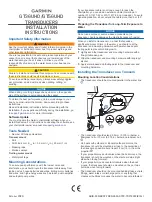
Measurement Specialties
KPSI
®
Digital Series User’s Manual
Page 6
www.Meas-Spec.com
I n s t a l l a t i o n
The transducers are designed for rugged use; however, they need protection from over-
pressure and sharp impact. They are designed to be used in a vertical orientation with the
sensing diaphragm facing downward. For greatest accuracy, re-calibrations should be
performed with the transducer in this position.
When lowering the transducer into a liquid, penetrate the surface slowly and only to the depth
necessary. Avoid dropping the unit from above the surface. Clean the transducer’s surface by
rinsing it in a mile detergent. Direct probing of the diaphragm or attempts to remove protective
screens will damage the sensor and void the warranty.
Most users either suspend the transducer in a perforated 1-inch or 2-inch PVC instrumentation
free well or attach the transducer using our optional ½-inch MNPT to a rigid conduit. Some
applications use our optional mounting bracket (PN 49-06-00PC) to clamp the transducer to a
fixed object (i.e., wall, ladder, step).
Alternatively, because our cable has a 200 pound pull strength, the transducer may be
suspended without any protective still well, mounting clamp, or supporting cables. However,
users often use our cable hanger. This sensor (device) slides onto the cable from the bare wire
end. The cable hanger may be positioned anywhere on the cable by pushing the ends together.
Once positioned, the cable hanger contracts to provide a snug grip.








































